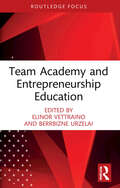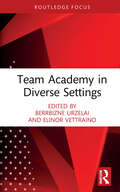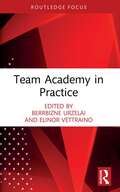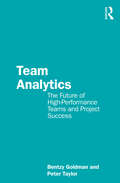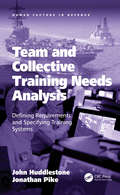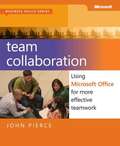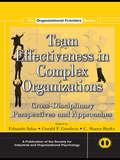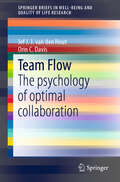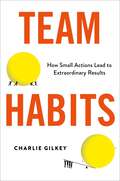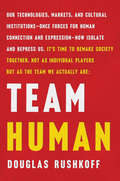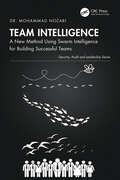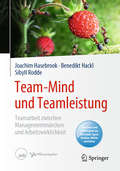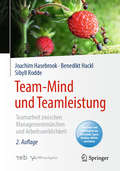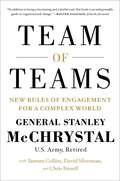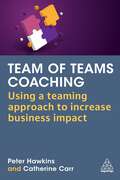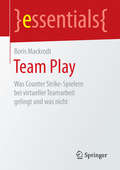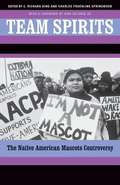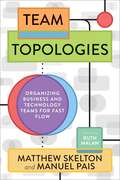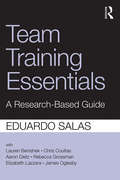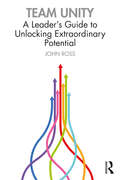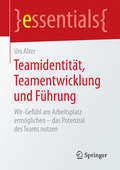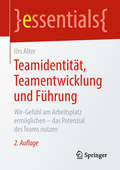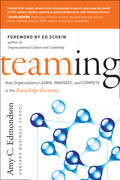- Table View
- List View
Team Academy: Leadership and Teams (Routledge Focus on Team Academy)
by Elinor VettrainoWithin Entrepreneurship Education, Team Academy is seen by some as an innovative pedagogical model that enhances social connectivity, as well as experiential, student-centred and team-based learning. It also creates spaces for transformative learning to occur. In this book, the third book in the four part Routledge Focus on Team Academy series, the contributors explore the concepts of leadership and teams in the context of TA. Topics including the way in which learners attempt to navigate the complexity of leadership and team dynamics, whilst understanding their place and impact on the processes involved, will be examined. This book is aimed at academics, practitioners, and learners engaged in the Team Academy methodology, pedagogy, and model, as well as those interested in the area of entrepreneurial team learning. Readers will be inspired to innovate in their delivery methodologies and to explore learning-by-doing approaches to creating value. The book also aims to challenge the discourse around entrepreneurship and entrepreneurial activities, offering insights, research, stories, and experiences from those learning and working in the Team Academy approach.
Team Academy and Entrepreneurship Education (Routledge Focus on Team Academy)
by Elinor Vettraino Berrbizne UrzelaiWithin Entrepreneurship Education, Team Academy (TA) is seen as an innovative pedagogical model that enhances social connectivity, as well as experiential, student-centred, and team-based learning. It also creates spaces for transformative learning to occur. This first book of the Routledge Focus on Team Academy book series examines the place and purpose of the TA model in entrepreneurship education, and indicates how and why the model has grown in popularity and interest over the last three decades. This book is aimed at academics, practitioners, and learners engaged in the TA methodology, pedagogy, and model, as well as those interested in the area of entrepreneurial team learning. Readers will be inspired to innovate in their delivery methodologies and to explore learning-by-doing approaches to creating value. The book also aims to challenge the discourse around entrepreneurship and entrepreneurial activities, offering insights, research, stories, and experiences from those learning and working in the TA approach.
Team Academy in Diverse Settings (Routledge Focus on Team Academy)
by Berrbizne Urzelai Elinor VettrainoWithin Entrepreneurship Education, Team Academy (TA) is seen by some as an innovative pedagogical model that enhances social connectivity, as well as experiential, student-centred, and team-based learning. It also creates spaces for transformative learning to occur. This fourth book of the Routledge Focus on Team Academy book series the TA model is examined outside of the traditional TA-based settings (industry, schools, communities of practice, etc.) in different countries (Brazil, Japan, UK, Finland, Argentina, Tanzania, Spain, etc.). The legacy that this has left in learners and practitioners who have engaged with the model is also explored. This book is aimed at academics, practitioners, and learners engaged in the Team Academy methodology, pedagogy and model, as well as those interested in the area of entrepreneurial team learning. Readers will be inspired to innovate in their delivery methodologies and to explore learning-by-doing approaches to creating value. The book also aims to challenge the discourse around entrepreneurship and entrepreneurial activities, offering insights, research, stories, and experiences from those learning and working in the Team Academy approach.
Team Academy in Practice (Routledge Focus on Team Academy)
by Berrbizne UrzelaiWithin entrepreneurship education, Team Academy is seen by some as an innovative pedagogical model that enhances social connectivity, as well as experiential, student-centred, and team-based learning. It also creates spaces for transformative learning to occur. This second book of the Routledge Focus on Team Academy book series includes chapters from contributors working with the TA methodology in academic institutions around the world that discuss the challenges, benefits, and approaches to embedding the TA methodology in practice (around coaching, assessment, transformative learning, partnerships, programme evolution, etc.). This book is aimed at academics, practitioners, and learners engaged in the Team Academy methodology, pedagogy, and model, as well as those interested in the area of entrepreneurial team learning. Readers will be inspired to innovate in their delivery methodologies and to explore learning-by-doing approaches to creating value. The book also aims to challenge the discourse around entrepreneurship and entrepreneurial activities, offering insights, research, stories, and experiences from those learning and working in the Team Academy approach.
Team Analytics: The Future of High-Performance Teams and Project Success
by Bentzy Goldman Peter TaylorWritten by authors who have real-world experience of leading teams and major projects, this book explores a new approach to project success: the continuous process of enabling and empowering teams to reach the optimal levels of performance. For decades, project managers have been asking the multi-million, and sometimes multi-billion-dollar question: why did the project fail? High project failure rates are nothing new and have been well documented, but when project professionals seek answers, they usually return to the original project plan to identify flaws. Yet there is one place where most don't look for the answers: the people. Here is the value gap of the almost untouched area of project team performance management that has the potential to be the next quantum leap in project success. PMO leaders, change executives, HR professionals, project managers, program managers, and portfolio managers – anyone who leads a team in the project world – will learn how to make this critical investment for any organization which wishes to thrive in the ‘new normal’ project-based economy.
Team and Collective Training Needs Analysis: Defining Requirements and Specifying Training Systems (Human Factors in Defence)
by John Huddlestone Jonathan PikeMilitary capability is delivered operationally at a team and collective level, be it a unit as small as a squad or section, or as large as a maritime task group. Modern military forces are required to deal with a potentially wide range of missions frequently involving multiple alliance partners, within a geopolitical environment which can seem to change rapidly. Individual performance, while being important, is not the primary determinant of mission success - force integration, interoperability, adaptability and teamwork are key factors. Team and collective training which fully addresses these factors is fundamental to the development and delivery of military capability. As a consequence, the requirement to determine training requirements and specify effective systems for the delivery of team and collective training is critical to operational success. Training Needs Analysis (also known as Front End Analysis), is a well-established methodology for analysing training requirements and specifying training solutions used extensively by the UK and its NATO partners. However, the analytical techniques employed are optimised for individual training, with little guidance being offered on its application in the team and collective context. Team and Collective Training Needs Analysis (TCTNA) has been developed to close this methodological gap. It addresses the issues of the relationship of individual and team tasks, teamwork, command and control, task and training environments, scenario definition, instructional strategy, team training approaches, instructional functions, and wide-ranging organisational and procurement considerations. Part One of the book develops an integrated set of models which underpin the analytical approach presented in Part Two. Worked examples and case studies illustrate the application of the approach. Between 2005 and 2015 the authors worked on numerous training-related research projects at Cranfield University and Coventry University for the Human Factors Integration Defence Technology Centre and the Defence Human Capability Science and Technology Centre on behalf of the Defence Science and Technology Laboratory, UK Ministry of Defence.
Team Collaboration: Using Microsoft® Office for More Effective Teamwork
by John Pierce<p>Whether coordinating a cross-team project or leading your workgroup, discover how to enable your team’s best work using Microsoft Office.</p>
Team Effectiveness In Complex Organizations: Cross-Disciplinary Perspectives and Approaches (SIOP Organizational Frontiers Series)
by Eduardo Salas Gerald F. Goodwin C. Shawn BurkeOver the past 40 years, there has been a growing trend toward the utilization of teams for accomplishing work in organizations. Project teams, self-managed work teams and top management teams, among others have become a regular element in the corporation or military. This volume is intended to provide an overview of the current state of the art research on team effectiveness.
Team Flow: The psychology of optimal collaboration (SpringerBriefs in Well-Being and Quality of Life Research)
by Jef J.J. van den Hout Orin C. DavisThis book presents a series of studies that conceptualize, test, and monitor team flow experiences in professional organizations to perform autonomously and successfully. It analyses the processes by which team flow emerges by exemplifying case studies, and introduces a protocol to spark team flow in professional organizations.
Team Habits: How Small Actions Lead to Extraordinary Results
by Charlie GilkeyDISCOVER SMALL, TEAM-BASED CHANGES THAT HAVE COMPANY-WIDE RESULTS. The teams we work in amplify our individual efforts, yet we constantly struggle to accomplish what is possible. You can see all the problems in a typical weekly meeting. No planning. Missing goals. Muddled communication. We think just bringing our personal hopes and desires will be enough. It&’s not. The groups we work in need collective habits as much as individuals need better personal habits. Determining team habits for things like planning, decision-making, and prioritization produce reliability and ease for everyone. Team habits create better work and let people work better together. In Team Habits, Charlie Gilkey explains how the revolution in personal habits has an even greater potential when applied to teams. With practical exercises, a Team Habits Quiz to evaluate areas for improvement, and a guide to create a team habits roadmap, Team Habits will help you transform your group so team members can flourish and thrive. If changing the smallest habit can yield powerful results for an individual, then just imagine what it can do for your team.
Team Human
by Douglas Rushkoff“A provocative, exciting, and important rallying cry to reassert our human spirit of community and teamwork.”—Walter Isaacson Team Human is a manifesto—a fiery distillation of preeminent digital theorist Douglas Rushkoff’s most urgent thoughts on civilization and human nature. In one hundred lean and incisive statements, he argues that we are essentially social creatures, and that we achieve our greatest aspirations when we work together—not as individuals. Yet today society is threatened by a vast antihuman infrastructure that undermines our ability to connect. Money, once a means of exchange, is now a means of exploitation; education, conceived as way to elevate the working class, has become another assembly line; and the internet has only further divided us into increasingly atomized and radicalized groups. Team Human delivers a call to arms. If we are to resist and survive these destructive forces, we must recognize that being human is a team sport. In Rushkoff’s own words: “Being social may be the whole point.” Harnessing wide-ranging research on human evolution, biology, and psychology, Rushkoff shows that when we work together we realize greater happiness, productivity, and peace. If we can find the others who understand this fundamental truth and reassert our humanity—together—we can make the world a better place to be human.
Team Intelligence: A New Method Using Swarm Intelligence for Building Successful Teams (Security, Audit and Leadership Series)
by Mohammad NozariIf you have wondered about mesmerizing patterns of flying birds and fish, and asked how they do it, then you have observed what biologists refer to as an intelligent swarm. It is as if the members of swarm are receiving commands on what to do. It is magic! In reality, it is an intriguing set of behaviors that many species including birds, fish, bats, wolves, honeybees, termites and many others have learnt during their millions of years of evolution, which has enabled them to succeed better and sustain their lives. We have learned and applied our learning from nature, and have been inspired to invent many things we use from this fabulous source: Mother Nature! The question that led to long research and this book is set to answer, might be strange and unique: Can we use nature for managing people and teams in companies? After all, social beings in nature seem to be able function very well, and recent research has revealed great approaches they take to make decisions, and work together. This book opens that exact interdisciplinary field, a bridge between managing teams and people in companies with how similar problems are solved in intelligent swarms. The research supporting this idea has led to a set of principles that will transform traditional teams into Intelligent Teams. These teams are capable of bringing performance, learning, and happiness of the team members to a new high level.
Team Leadership: How to Define, Apply, and Measure It
by Geoff Ribbens Mark Abraham Alistair CummingA small group of experienced business leaders and academics have teamed up to create an innovative and potentially disruptive approach to developing leadership in the 21st century. The result is a unique, people-centric, and scientifically researched theory of leadership linked to an accurate data-based assessment and diagnostic product. This is the result of several years of study and development as well as many years of curiosity and experience. This is a new approach to leadership development. The authors use a combination of leadership experience, research, and science to move away from unprovable theory and subjective judgment to deliver a definable product with unlimited application. For individual leaders looking to maximise personal development and results or for organisations wanting to analyse leadership and its effects across an entire structure or business, this book will redefine understanding and development. The work has proved that team members’ perceptions of a leader and leadership behaviours will define their motivation, willingness, loyalty, output, and mental health far more than the actual leadership behaviours themselves. The authors’ application of Emergent Team Leadership Theory, why and to what degree team members attribute leadership to their leaders, directors, or managers, leads to accurate assessments of how leaders and leadership are viewed in teams, businesses, and organisations. Importantly, the work is so accurate that individual leaders can define precisely where to focus their personal development to get the most from themselves and their teams. Even for leaders and managers of the same grade in the same role, personal leadership development and training will be different. This work has developed the Leadership Pathway Audit™ that measures the effectiveness of leadership for any leader or any team and will, over time, chart how leadership changes as any factor of the leader, the team, or the situation changes. Each leader, director, or manager gets a unique representation of the perception of their leadership at any time and a detailed report on the data and perceptions behind this representation. There are limitless options for following this with bespoke analysis of an individual’s leadership and for personal development programs tailored to their profile and organisation. Equally, reviewing the entirety of a business or organisation’s leadership profiles gives an incredibly accurate view of leadership across an entire company organisation, or sector.
Team-Mind und Teamleistung: Teamarbeit zwischen Managementmärchen und Arbeitswirklichkeit
by Joachim Hasebrook Benedikt Hackl Sibyll RoddeWie können Teams den Erfolg von Organisationen steigern?Wann schaffen Mitarbeiter in Teams wirklich mehr als alleine? Entscheiden Teams ausgewogener als Einzelne?Führt eine gute Teamatmosphäre wirklich zu mehr Leistung?Können Roboter und Künstliche Intelligenz zu Teamkollegen werden?Aus der Wissenschaft für die Praxis gibt dieses inhaltlich breit aufgestellte Buch fundierte, richtungsweisende und praxisnahe Antworten auf Fragen zum Thema „Team“. Basierend auf aktuellen Erkenntnissen der Sozial-, Arbeits- und Neuropsychologie zeigen die Autoren an vielen praxisrelevanten Beispielen und anhand von Interviews mit erfahrenen Managern aus Spitzensport, Wirtschaft, Militär und Wissenschaft, wie Teamführung in Organisationen sinnvoll umgesetzt wird und Teams erfolgreich agieren können.Erfahren Sie, wie auch Sie in Ihrer Organisation oder in Ihrem Team die gesamte Teamleistung dauerhaft steigern können.Zielgruppen:Alle, die selbst in Teams arbeiten, z. B. Teamleiter in Dienstleistung, Verwaltung oder IndustrieMitarbeiter in teamorientierten Organisationen Vorstände und AufsichtsräteManager und TeamverantwortlicheAlle, die Voraussetzungen für Teamarbeit verbessern wollen, z. B. Strategie- und ManagementberaterIngenieure für im Team verwendete MaschinenArchitekten von ArbeitsräumenDesigner von ArbeitsumgebungenForscher an Hochschulen und in Unternehmen
Team-Mind und Teamleistung: Teamarbeit zwischen Managementmärchen und Arbeitswirklichkeit
by Joachim Hasebrook Benedikt Hackl Sibyll RoddeWie erfolgreich eine Organisation ist, wird dadurch bestimmt, wie gut die Mitarbeitenden in ihr zusammenarbeiten. Krisenzeiten machen das besonders deutlich und stellen zugleich besondere Anforderungen an die Zusammenarbeit: Krisenstäbe werden gebildet, Teammitglieder arbeiten plötzlich getrennt und virtuell, Unsicherheit durch psychische Belastungen und Cyberattacken wächst. Jenseits von Binsenwahrheiten und simplen Erfolgsrezepten gibt dieses Managementbuch psychologisch und betriebswirtschaftlich fundiert Antworten, wie erfolgreiche Teamarbeit auch in Krisenzeiten funktioniert. Sie erfahren, wie Sie Teamleistungen fördern und was Sie von Hochleistungsteams lernen können. Mit zahlreichen Beispielen aus der Praxis und in Interviews führender Expertinnen und Experten aus Industrie, Wissenschaft, Medizin, Militär und Spitzensport wird leicht verständlich und unterhaltsam erläutert, wie man Trendsetter für bessere Teamleistung wird. Das Buch ist von einem Organisationspsychologen, einem Betriebswirt und einer klinischen Psychologin verfasst und daher interdisziplinär und breit anwendbar angelegt. Es beruht auf über 15 Jahren Praxis- und Forschungserfahrung sowie topaktuellen Erkenntnissen der Sozial-, Arbeits- und Neuropsychologie. Das Buch wendet sich an alle, die in Entscheidungsgremien, Entwicklungs- und Produktionsteams oder in der Teamleitung arbeiten. Es ist auch wertvoll für Teamtrainer, Coaches, Berater sowie Designer und Architekten, die Teamarbeitsplätze entwickeln.
Team of Teams: New Rules of Engagement for a Complex World
by David Silverman General Stanley Mcchrystal Chris Fussell Tantum CollinsWhat if you could combine the agility, adaptability, and cohesion of a small team with the power and resources of a giant organization? THE OLD RULES NO LONGER APPLY . . . When General Stanley McChrystal took command of the Joint Special Operations Task Force in 2004, he quickly realized that conventional military tactics were failing. Al Qaeda in Iraq was a decentralized network that could move quickly, strike ruthlessly, then seemingly vanish into the local population. The allied forces had a huge advantage in numbers, equipment, and training—but none of that seemed to matter.TEACHING A LEVIATHAN TO IMPROVISE It’s no secret that in any field, small teams have many advantages—they can respond quickly, communicate freely, and make decisions without layers of bureaucracy. But organizations taking on really big challenges can’t fit in a garage. They need management practices that can scale to thousands of people. General McChrystal led a hierarchical, highly disciplined machine of thousands of men and women. But to defeat Al Qaeda in Iraq, his Task Force would have to acquire the enemy’s speed and flexibility. Was there a way to combine the power of the world’s mightiest military with the agility of the world’s most fearsome terrorist network? If so, could the same principles apply in civilian organizations?A NEW APPROACH FOR A NEW WORLD McChrystal and his colleagues discarded a century of conventional wisdom and remade the Task Force, in the midst of a grueling war, into something new: a network that combined extremely transparent communication with decentralized decision-making authority. The walls between silos were torn down. Leaders looked at the best practices of the smallest units and found ways to extend them to thousands of people on three continents, using technology to establish a oneness that would have been impossible even a decade earlier. The Task Force became a “team of teams”—faster, flatter, more flexible—and beat back Al Qaeda. BEYOND THE BATTLEFIELD In this powerful book, McChrystal and his colleagues show how the challenges they faced in Iraq can be relevant to countless businesses, nonprofits, and other organizations. The world is changing faster than ever, and the smartest response for those in charge is to give small groups the freedom to experiment while driving everyone to share what they learn across the entire organization. As the authors argue through compelling examples, the team of teams strategy has worked everywhere from hospital emergency rooms to NASA. It has the potential to transform organizations large and small.From the Hardcover edition.
Team of Teams Coaching: Using a Teaming Approach to Increase Business Impact
by Peter Hawkins Dr Catherine CarrFor an organization to be successful in the mid-21st century, it is important for all of its teams to be more than the sum of their parts and the organization's team of teams to be more than the sum of the teams. The ability to team with all stakeholders in a quick and agile manner can be a defining difference from other organizations.Written by the leading global thought leaders on teaming and systemic team coaching, Teams of Teams Coaching provides practical guidance on developing an organizational strategy and culture that delivers critical advantages. It covers the need for team of teams coaching, the benefits of this approach and how to build and implement a team of teams coaching strategy. There is also guidance on how to develop a teaming culture in the organization, building internal team coaching capacity and what to consider when exploring external coaching support.Full of global research of best practice from over seventy organizations from different sectors, as well as the authors' combined seventy years of working with coaching organizations and the team of teams, this book provides a clear map of the process to become an effective team of teams. This evidence-based guide contains methods and tools that leaders, coaches and consultants can immediately use to achieve improved performance and gain competitive advantage.
Team Play: Was Counter Strike-Spielern bei virtueller Teamarbeit gelingt und was nicht (essentials)
by Boris MackrodtDer Autor stellt in diesem essential f#65533;r das als klassisch geltende Team-Computerspiel Counter Strike dar, welches die Grundlagen und Bedingungen einer erfolgreichen Online-Kooperation sind und inwieweit unter dem Stichwort Gamification ein #65533;bertrag in die Arbeitswelt gelingen kann. Denn in jeder Sekunde kooperieren weltweit Millionen von Menschen online und bilden neue Gesellungsformen, um ein gemeinsames Spielziel zu erreichen. Online-Computerspiele k#65533;nnen aus dieser Sicht als Benchmark f#65533;r gelungene virtuelle Kooperation gesehen werden.
Team Spirits: The Native American Mascots Controversy
by Charles Freuhling Springwood C. KingA growing controversy in recent years has arisen around the use and abuse of Native American team mascots. The Cleveland Indians, Atlanta Braves, Washington Redskins, Kansas City Chiefs, Florida State Seminoles, and so forth--these are just a few of the images and names popularly associated with Native Americans that are still used as mascots by professional sports teams, dozens of universities, and countless high schools. This practice, a troubling legacy of Native-Euro-American relations in the United States, has sparked heated debates and intense protests that continue to escalate. Team Spirits is the first comprehensive look at the Native American mascots controversy. In this work activists and academics explore the origins of Native American mascots, the messages they convey, and the reasons for their persistence into the twenty-first century. The essays examine hotly contested uses of mascots, including the Washington Redskins, the Cleveland Indians, and the University of Illinois's Chief Illiniwek, as well as equally problematic but more complicated examples such as the Florida State Seminoles and the multitude of Native mascots at Marquette University. Also showcased are examples of successful opposition, including an end to Native American mascots at Springfield College and in Los Angeles public schools. C. Richard King is an assistant professor of anthropology at Drake University, and Charles Fruehling Springwood is an assistant professor of anthropology at Illinois Wesleyan University. King and Springwood are coauthors of the forthcoming book Beyond the Cheers: Race As Spectacle in College Sport.
Team Topologies: Organizing Business and Technology Teams for Fast Flow
by Matthew Skelton Manuel PaisEffective software teams are essential for any organization to deliver value continuously and sustainably. But how do you build the best team organization for your specific goals, culture, and needs? Team Topologies is a practical, step-by-step, adaptive model for organizational design and team interaction based on four fundamental team types and three team interaction patterns. It is a model that treats teams as the fundamental means of delivery, where team structures and communication pathways are able to evolve with technological and organizational maturity.In Team Topologies, IT consultants Matthew Skelton and Manuel Pais share secrets of successful team patterns and interactions to help readers choose and evolve the right team patterns for their organization, making sure to keep the software healthy and optimize value streams.Team Topologies is a major step forward in organizational design for software, presenting a well-defined way for teams to interact and interrelate that helps make the resulting software architecture clearer and more sustainable, turning inter-team problems into valuable signals for the self-steering organization.
Team Training Essentials: A Research-Based Guide
by Eduardo SalasTeam Training Essentials succinctly outlines best practices for team training, as based in the latest organizational psychology research. Organized into 5 ‘pillars,’ this clear, accessible guide covers all aspects of team training, from design and delivery to evaluation, transfer, and sustainment methods. Useful for anyone studying team dynamics and performance as well as group training, this book will also be of interest to professionals looking to apply team training practices in real business settings.
Team Unity: A Leader's Guide to Unlocking Extraordinary Potential
by John RossBased on more than ten years of researching, observing, coaching, and building extraordinary teams, this entertaining and thought-provoking book demonstrates how to unify groups of all sizes to maximize performance. Unity is the most influential factor in team performance and, although it is frequently discussed, it is often misunderstood. This book explains how disunity is the root cause of all team dysfunctions, and provides clear instructions on how to define, measure, and increase unity in your organization. Through entertaining and impactful stories, John Ross divides Team Unity into four components - focus, direction, trust, and conflict – and examines how they are related and measured. Notably, Ross introduces The Unity Formula: a simple equation useful for leaders at all levels in any organization to measure the team’s current unity and identify areas for improvement. Senior and middle managers in manufacturing, hospitality, and a range of other industries, as well as entry level employees and students of organizational behavior and HRM, will find this book an invaluable resource for understanding how to identify, measure and partake in the right steps to increase team performance.
Teamidentität, Teamentwicklung und Führung: Wir-Gefühl am Arbeitsplatz ermöglichen – das Potenzial des Teams nutzen (essentials)
by Urs AlterDr. Urs Alter veranschaulicht wichtige Zusammenhänge zwischen Teamführung und Arbeitsleistung. Dabei wird deutlich, dass Mitarbeitende ihre Identität auch in der Arbeitsrolle finden müssen, wenn von ihnen Engagement verlangt wird. Der Autor beschreibt, wie Führungskräfte dies ermöglichen können und wie eine Teamidentität geschaffen wird, die als „Wir-Gefühl“ das Verhalten im Team nachhaltig und wirksam prägt. Im Zentrum des Praxisbezugs stehen die Teamentwicklung und die Verankerung von Leitgedanken: Vision, Mission, Wertvorstellungen. Schließlich ermutigt das essentialFührungskräfte, sich mit tiefer gehenden Fragen nach Sinn und Zweck der Arbeit auseinanderzusetzen, wenn sie erfolgreich bleiben wollen.
Teamidentität, Teamentwicklung und Führung: Wir-Gefühl am Arbeitsplatz ermöglichen – das Potenzial des Teams nutzen (essentials)
by Urs AlterDr. Urs Alter veranschaulicht wichtige Zusammenhänge zwischen Teamführung und Arbeitsleistung. Dabei wird deutlich, dass Mitarbeitende ihre Identität auch in der Arbeitsrolle finden müssen, wenn von ihnen Engagement verlangt wird. Der Autor beschreibt, wie Führungskräfte dies ermöglichen können und wie eine Teamidentität geschaffen wird, die als „Wir-Gefühl“ das Verhalten im Team nachhaltig und wirksam prägt. Im Zentrum des Praxisbezugs stehen die Teamentwicklung und die Verankerung von Leitgedanken: Vision, Mission, Wertvorstellungen. Schließlich ermutigt das essentialFührungskräfte, sich mit tiefer gehenden Fragen nach Sinn und Zweck der Arbeit auseinanderzusetzen, wenn sie erfolgreich bleiben wollen. Für die vorliegende zweite Auflage wurde das essential gründlich durchgesehen und auf den aktuellen Forschungsstand gebracht.
Teaming
by Amy C. EdmondsonNew breakthrough thinking in organizational learning, leadership, and change Continuous improvement, understanding complex systems, and promoting innovation are all part of the landscape of learning challenges today's companies face. Amy Edmondson shows that organizations thrive, or fail to thrive, based on how well the small groups within those organizations work. In most organizations, the work that produces value for customers is carried out by teams, and increasingly, by flexible team-like entities. The pace of change and the fluidity of most work structures means that it's not really about creating effective teams anymore, but instead about leading effective teaming. Teaming shows that organizations learn when the flexible, fluid collaborations they encompass are able to learn. The problem is teams, and other dynamic groups, don't learn naturally. Edmondson outlines the factors that prevent them from doing so, such as interpersonal fear, irrational beliefs about failure, groupthink, problematic power dynamics, and information hoarding. With Teaming, leaders can shape these factors by encouraging reflection, creating psychological safety, and overcoming defensive interpersonal dynamics that inhibit the sharing of ideas. Further, they can use practical management strategies to help organizations realize the benefits inherent in both success and failure. Presents a clear explanation of practical management concepts for increasing learning capability for business results Introduces a framework that clarifies how learning processes must be altered for different kinds of work Explains how Collaborative Learning works, and gives tips for how to do it well Includes case-study research on Intermountain healthcare, Prudential, GM, Toyota, IDEO, the IRS, and both Cincinnati and Minneapolis Children's Hospitals, among others Based on years of research, this book shows how leaders can make organizational learning happen by building teams that learn.

